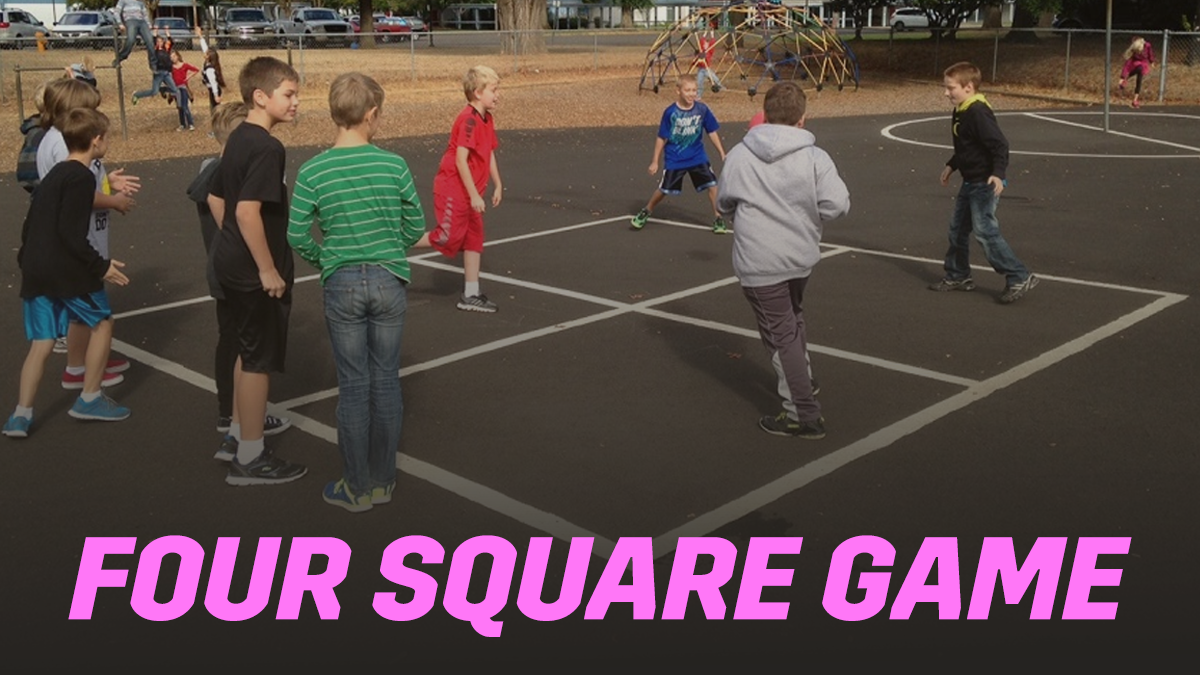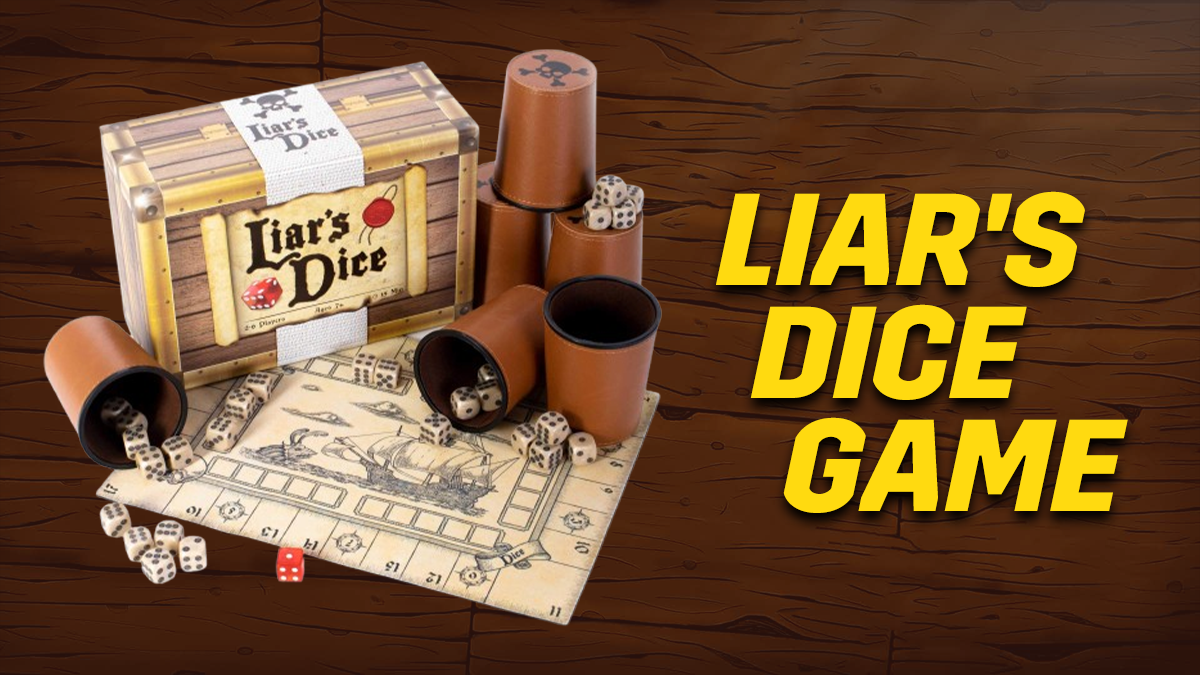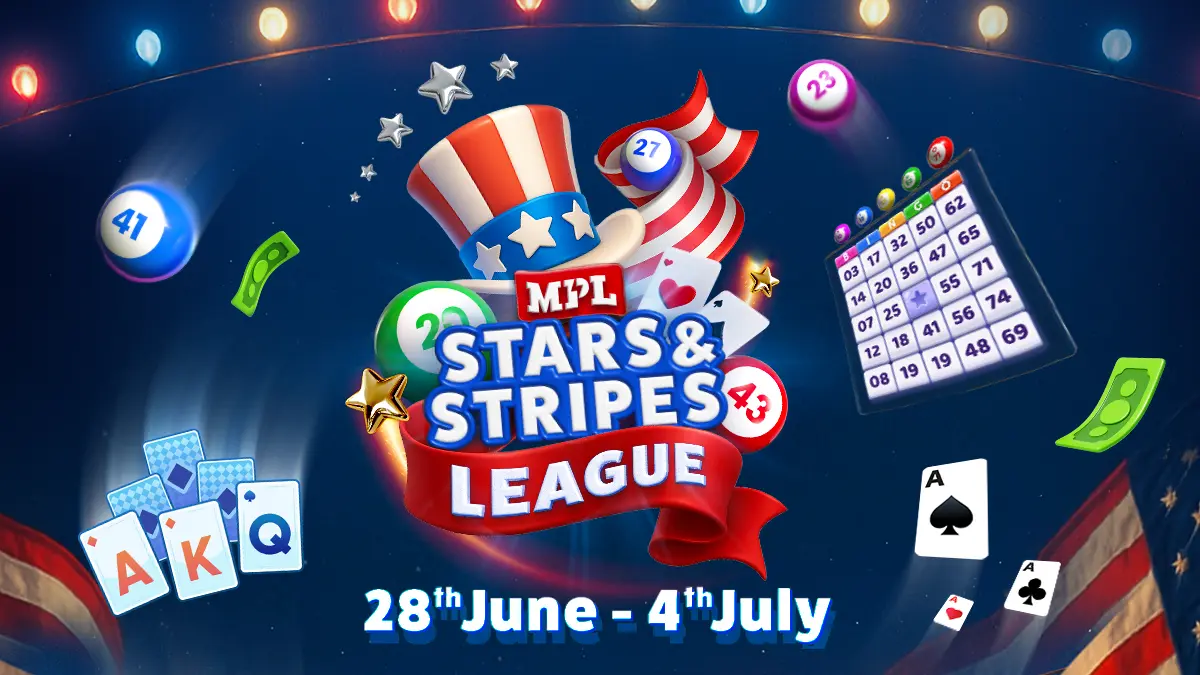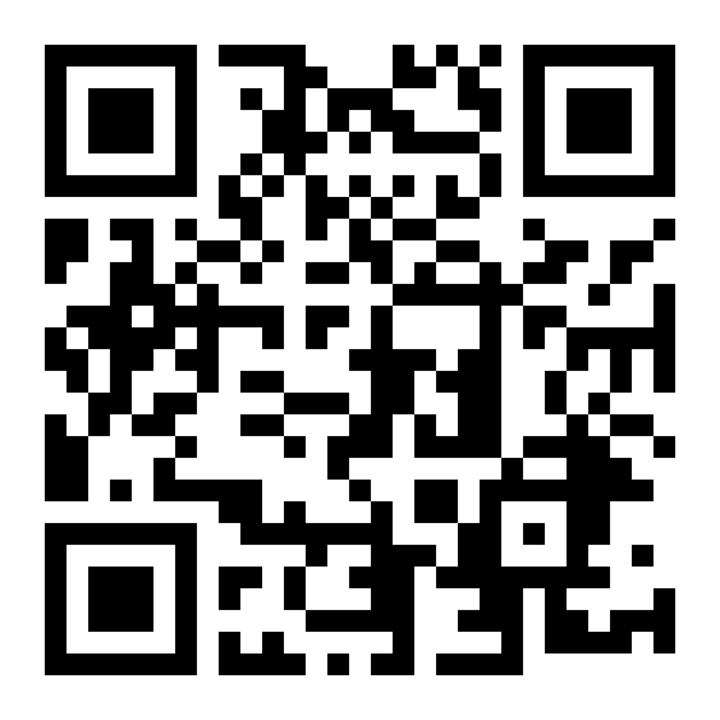Table of Contents
ToggleFour Square is a fun outdoor game that anyone can play. Especially if you want to play with the big ball but can’t choose between Football or Basketball! The Four Square game is chill too, encouraging friendly competition, unlike those fierce competitions.
Adults, kids, elders, everyone can play without hesitation. There’s enough physical exertion. No wonder the Four Square game has been such a popular game in the USA. The game’s simple rules, safe maneuvers, and quick setup are only a few reasons to play the game. How can beginners start? Are YOU a beginner? Go through the rules given below and then you’re ready.
What is the Four Square Game?
Four Square is a ball game played on a square court divided into four equal sections, each occupied by one player. The game can be quickly set up in backyards and playgrounds. The squares are ranked from highest to lowest, e.g., 1 to 4.
Players use a rubber playground ball, bouncing it between squares using open-handed hits. The goal is to eliminate players in higher-ranked squares through faults like missed hits, out-of-bounds shots, or rule violations. When a player is eliminated, others move up in rank. A new player enters Square 4. The game continues in rotation, emphasizing adherence to court boundaries and hitting rules.
Basic Rules for Four Square Game
- Four players each stand in one of the four squares on the court.
- The player in Square 1 serves the ball by bouncing it once in their square, then hitting it to another square.
- The receiving player must let the ball bounce once in their square, then hit it to any other square.
- Only the player whose square the ball lands in can hit it next.
- If you miss the ball, hit it out of bounds, or let it bounce twice, you’re eliminated.
- When a player is eliminated, everyone moves up to a higher square. A new player joins Square 4.
The four square game rules are flexible and adaptable. Ensure that the rules are properly explained before starting the game to avoid unnecessary disputes, including any adaptations.
Sport Game: Learn how to play Shuffleboard with official game rules and tips
How to Play Four Square Game for Beginners
Objective
In detail, the goal of Four Square is to move up to the top square by getting other players out. The game is played on the court described above. Each player stands in one square. Players bounce a rubber ball to each other, trying to keep the ball in play.
If someone makes a mistake, like missing the ball or hitting it out, they’re out. Everyone else advanced to the next higher square. A new player steps into the lowest square to join the game.
Serving the Ball
The player in the highest-ranked square (Square 1) starts the game as per the basic rules. If you decide that Square 4 is the highest, start the service from there.
As we have ranked Square 1 as the top, the service always goes diagonally to Square 4.
Here’s how you serve:
- Hold the ball and drop it onto your square.
- Let the ball bounce once, then hit it into Square 4.
- The receiving player lets it bounce once in their square, then hits it into another player’s square.
Once the receiving player hits the ball, the game is officially in play!
One “Fault” Allowed
Beginner players, here’s a helpful rule: you’re allowed one mistake (a fault) when receiving a serve each round. For example, if the receiver accidentally hits the ball out of bounds or misses it, that’s “one bad.” But be careful! Make a second mistake, and that’s “two bad”—meaning you’re eliminated.
Rules About Hitting the Ball
After the ball bounces in your square, it’s your turn.
- Only use your hands—the area from your wrists to your fingertips. You can use either the front or back of your hands.
- You must hit the ball instantly. No catching, carrying, or holding is allowed.
- Spinning the ball is allowed if done with a single, quick hit. Popular spins include back spin and side spin.
- Avoid using two hands to spin the ball in opposite directions—it can be considered carrying or holding.
Only the player who owns the square where the ball bounced must hit it next.
You don’t need to remain inside your square the whole time. But you should stay nearby enough to protect your space and be ready to return the ball.
- Each player can hit the ball only once per turn.
- If someone hits your ball before you do (called “poaching”), they’re out.
Getting Eliminated – How it Happens
Learning how to stay in the game means knowing what eliminates players. Here are the main reasons you might be eliminated:
- You fail to hit the ball into another player’s square.
- The ball bounces twice or more in your own square.
- You hit the ball out-of-bounds or onto an inside line.
- You catch, hold, or carry the ball.
- You hit the ball using anything other than your hands.
- You hit the ball when it’s not your turn (poaching).
Clarification on Poaching
Poaching in Four Square happens when a player hits the ball before the player whose square it landed in has a chance to hit it. It is against the rules and results in the poacher being out.
Here’s how it works: once the ball lands in a square, only the owner of that square is allowed to hit it next. If someone else hits it first, that’s poaching. Even if the ball bounces high or slowly, it’s still that player’s responsibility to return it.
However, once a player legally hits the ball, anyone can touch it before it lands in another square again. It can bounce off hands and bodies or be passed through the air multiple times. It’s still fair. But once it lands again in a square, possession resets. Only the player in that square may hit it.
Breaking the rule, even by accident, ends your turn.
Fouls and Outs
| Violation | Description |
|---|---|
| Double Bounce | Allowing the ball to bounce twice in your own square before returning it. |
| Out of Bounds | The ball lands outside the court boundaries. |
| Holding the Ball | Catching or holding the ball instead of quickly bouncing it back. |
| Illegal Hits | Using fists, feet, or other body parts instead of open or cupped hands to hit. |
When someone is eliminated, the remaining players advance to fill higher squares, and a new player enters Square 4— the lowest-ranked square.
Handling Interference
What if the ball hits something outside the four players or the court (like a backpack or a person waiting)? That’s called “interference.” No worries! Just start that round over. But players waiting in line should not touch the ball when the game is on.
Handling Ambiguity
Sometimes the game moves so fast it can be tough to tell exactly what happened. To avoid arguments, follow these two simple rules:
- “Is It Obvious?” Rule: If it’s clearly obvious what happened, address it calmly. If it’s not obvious, simply continue playing.
- “Own It” Rule: Everyone makes mistakes. Instead of arguing, acknowledge it, learn from it, and continue playing. It’s a great skill in Four Square—and in life!
You can also have a Showdown! The two disputing players get into a quick mini-game called “two square.” The player in the higher-numbered square serves to the lower-ranked square. The loser steps out of the game, and the winner stays in. No fuss, no arguing.
The Four Square Court
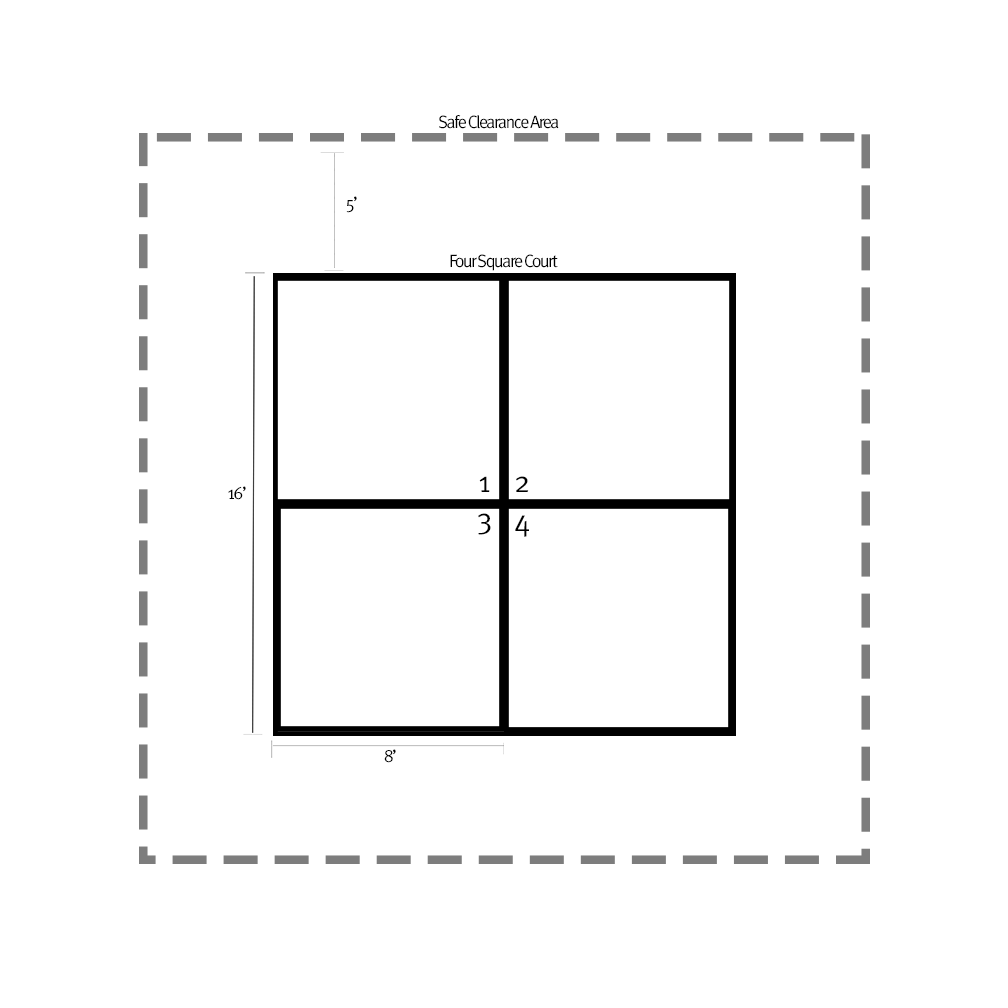
Source: Squarefour.org
Imagine drawing a large square and dividing it into four smaller squares—that’s your Four Square court! Each player stands in one smaller square. Officially, a Four Square court measures 16 feet on each side, divided into four equal 8-foot squares.
Squares are ranked from highest (number 1) to lowest (number 4). While we used numbers in the discussion, you can also use letters or royal names.
The highest and lowest-ranked squares must be diagonally opposite each other. Square 1 should be diagonal across from Square 4, not adjacent. Positions 2 and 3 are also diagonal.
There are two types of lines:
- Outside lines: These lines surround the entire court and are considered in-bounds. If the ball touches these lines, the play continues.
- Inside lines: These lines separate each smaller square. Hitting the ball onto any inside line means you’re out of the game for that round!
It’s easy to create your court—use sidewalk chalk or professional paint. For safe play, you should have at least 5 feet of clearance around it.
Personal Care
- Wear grippy shoes so you don’t slip.
- Wear stretchy clothes so you can move easily.
- Wear pads to protect your knees, elbows, hips, and wrists.
You may also play music to make the game more enjoyable.
Getting to Know Your Four-Square Ball
The official Four Square ball is an 8.5-inch rubber playground ball inflated to 2 lbs, commonly known as a “playground ball” or “kickball.” Brands like Champion PG8.5 are favorites due to their sturdy two-ply rubber construction and grippy texture. But don’t worry if you don’t have an official ball—soccer balls, volleyballs, or any inflatable ball that bounces at least half the height you drop it from will work great!
How to hold the ball is a big lesson when learning how to play the four square game. Players who handle the ball incorrectly are eliminated outright.
In Australia, players often use smaller 3-inch (7.6 cm) felted tennis balls for Four Square.
Tip: To keep your ball in good shape, store it partially deflated during long periods without use.
Tips for Beginner Players
- Aim and Placement: Focus on gently aiming the ball towards difficult-to-reach corners of your opponent’s squares.
- Watch and Anticipate: Keep an eye on other players’ patterns and anticipate where they’ll hit the ball next.
- Stay Calm: Stay relaxed to react quickly and control your hits. Panicking leads to mistakes.
- Consistent Bounce: Try to hit the ball with a consistent bounce height, making your returns more predictable and accurate.
- Avoid Fouls: Learn to handle the ball correctly to avoid getting eliminated.
Variations of Four Square
Exploiting the adaptable nature of the Four Square game, many variations of the game have emerged based on the number of players, ball-holding mechanics, etc.
- Catch-and-Throw Version: For younger kids or beginners, allow players to catch the ball before tossing it to another square. It makes the game easier and more enjoyable for those still learning coordination.
- Two Players per Square: If you have 8 or more players, you can play in teams of 2. When one player hits the ball, they rotate out, and their teammate jumps in. If one teammate is eliminated, the whole team is out, unless players agree to let the second teammate continue until they’re also out.
- Australian Rules: In the Australian version, players must bounce the ball in their own square first before sending it to another. Also, balls that land on any line are considered in play. The game is slightly more forgiving.
- Black Jack Mode: The fast-paced version that allows players to catch the ball before it bounces in their square. If they succeed, the player who hit the ball is out. It speeds up eliminations and keeps the game moving quickly.
- Server’s Rule Round: The player in Square 1 can introduce a temporary rule for each round. Everyone must follow it, but once the round ends, the rule resets. For example:
- 7-Up: Players must count up with each hit. If a player says a number ending in 7 or a multiple of 7, they must skip it, or they’re out.
- Underhand Rule: Players are only allowed to use the back of their hand for hitting. The palms must face up.
Russian Four Square
Russian Four Square is a variation of the traditional Four Square game that originated in the Soviet Union. It differs from the standard version in both structure and objective.
The court is divided into four squares: Peasant, Duke, Prince, and King. The Peasant serves the ball diagonally into the center, and play continues as each player hits the ball into another square. The aim is to climb the ranks and hold the King’s square, gaining control while others try to knock you out.
Players begin with five points and lose points through specific fouls or based on how the ball is hit—different body parts cause different point deductions.
For example, hitting the ball with your head deducts three points from the receiver, while landing it in the central “solid” square removes all five points.
If a player loses all points, they return to the Peasant square or the end of the line. A scorekeeper, called the stoner, tracks scores using small stones placed beside each square.
The game ends when one player reaches 20 points; the player with the lowest score at that moment is the winner.
Etiquette for Playing Four Square
Good sportsmanship matters. Here are etiquette pointers to keep the game enjoyable:
- Be honest and fair about calls. If unsure, replay the point.
- Keep the line moving and give everyone a chance to play.
- Encourage and be supportive of new players.
Benefits of Playing Four Square
- Physical Exercise: Enhances hand-eye coordination, agility, and fitness.
- Social Interaction: Builds communication skills, friendships, and teamwork.
- Accessibility: Easy for players of all ages and abilities to join.
A Brief History of Four Square Game
The history of the Four Square game goes at least back to the 1950s. The game was mentioned in northeastern U.S. newspapers from that era. It kept on gaining popularity in schools and playgrounds across America. 1953 teacher’s manual documents strikingly the same rules as those used today. Although exact origins are uncertain, some historians suggest Four Square may have evolved from “Jeu de paume,” a handball-style game popular in France since the 12th century.
Four Square quickly became beloved for its ease of play and adaptability. The game’s official rules evolved over the decades, adapted and molded by generations of schoolchildren. By the late 20th century, there were many structured leagues and standardized guidelines. Four Square became a recognized recreational activity worldwide.
Additional Thoughts
When learning Four Square game rules, many beginner players focus only on hitting the ball correctly. They often overlook positioning and timing. Learning where to stand and when to move can make a big difference in how long you stay in the game.
Practice staying alert between plays, adjust your stance based on ball direction and stay light on your feet. The ball can change direction quickly, so reacting fast matters as much as technique. Try short practice sessions focused only on movement and footwork before joining longer games. These habits will help you avoid early elimination and develop stronger control.
FAQs
Is punching allowed in the four square ball game rules?
No, punching is not allowed in Four Square rules. Players must use open or cupped hands to hit the ball. Using fists, elbows, or any other body parts is considered an illegal hit and results in elimination.
What is a shoe shiner in Four Square game?
A shoe shiner in Four Square is when a player hits the ball so it rolls or skims low across the ground, making it difficult to return. It’s often considered a trick shot or borderline legal move, depending on house rules.
Can a player hit the ball before it bounces in their square?
No, a player must let the ball bounce once in their square before hitting it. Hitting the ball before it bounces (called an “air hit”) is usually not allowed. It could be considered a foul unless your local rules say otherwise.
What happens if two players hit the ball at the same time?
If it’s unclear who touched the ball first or if both players hit it together, the point should be replayed. This falls under the “Is It Obvious?” rule to keep things fair.
Are smashes allowed?
It depends on the house rules. But in many games, smashes are allowed as long as they follow all hitting rules (e.g., no carrying or illegal spin).
What if the ball is unplayable?
If the ball is legally hit into your square, even if it rolls or stops dead, you are still out if you fail to return it. An unplayable ball is still playable by the rules, no exceptions.
How long can a player hold the ball before serving?
As per Four Square ball game rules, there’s no formal time limit. But to keep the game moving, players are expected to serve promptly. Taking too long could result in a warning or losing your square in competitive settings.

